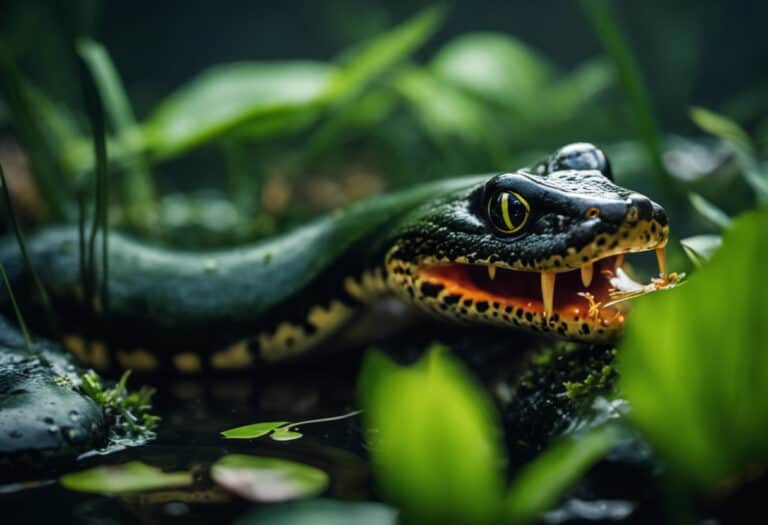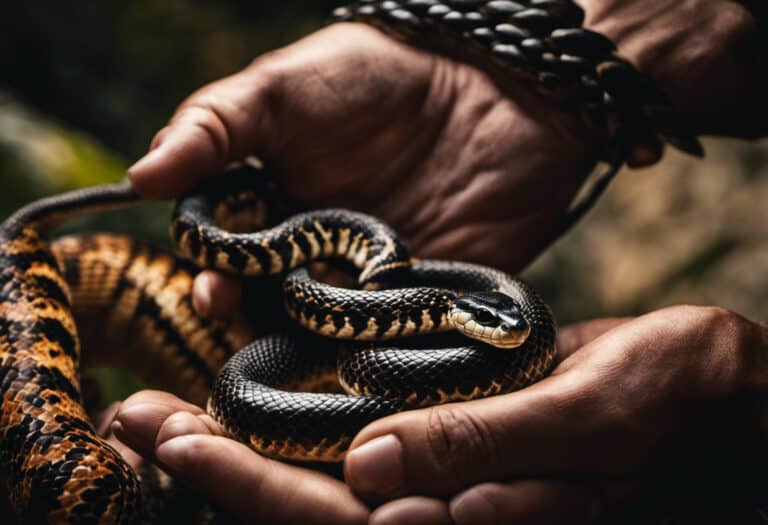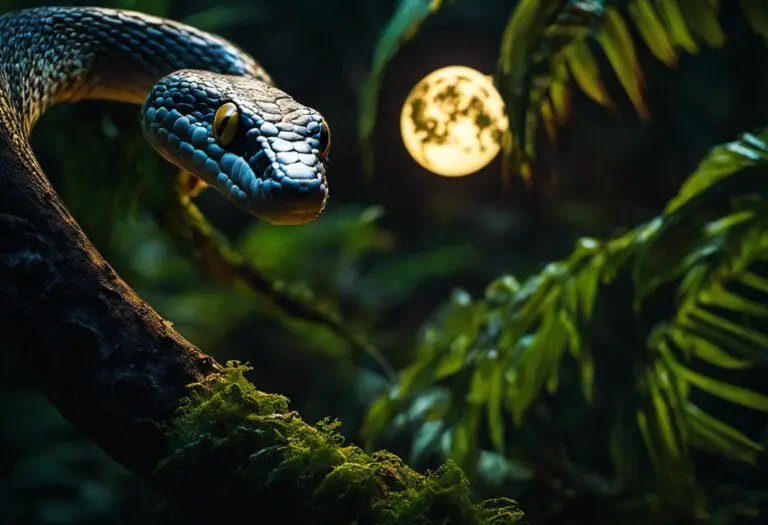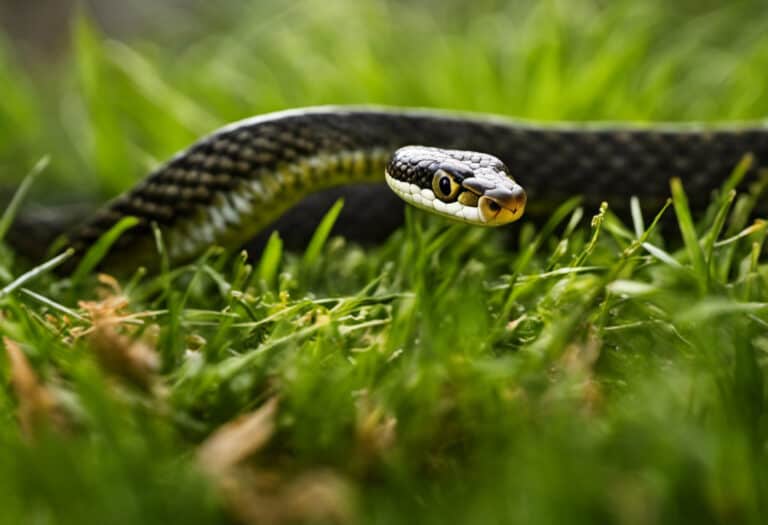Do Snakes Blink Their Eyes?
Do you ever ponder the peculiar possibility of snakes blinking their eyes? Prepare to be astounded, for these slithering creatures possess a fascinating secret. Contrary to our own ocular abilities, snakes lack eyelids and therefore cannot partake in the act of blinking.
Instead, they rely on specialized eye scales, which shield their delicate orbs from harm and dehydration. In this article, we shall delve into the captivating realm of snake eyes, exploring their unique adaptations, extraordinary vision, and astonishing accuracy when striking their prey.
Brace yourself for a voyage into the enthralling world of snakes and their enigmatic eye scales!
Key Takeaways
- Snakes do not have eyelids and cannot blink or close their eyes.
- Instead of eyelids, snakes have small, clear scales called eye scales.
- Eye scales protect the eyes from injury and prevent them from drying out.
- Despite not having eyelids, snakes can sleep without any issues.
Snakes’ Lack of Eyelids
You may be wondering why snakes don’t have eyelids.
Snakes lack eyelids because they’ve evolved a unique adaptation to protect their eyes called eye scales. These small, clear scales, also known as spectacles or brilles, cover and shield the snake’s eyes.
Unlike traditional eyelids, the eye scales are a specialized version that provide continuous eye protection.
Snakes need this protection because their eyes are constantly exposed to potential hazards, such as debris and dust, due to their close proximity to the ground. Without eyelids, snakes rely on their brain to regulate their sleeping mechanism and can sleep with their eyes open.
Despite not having eyelids, snakes have clear vision thanks to their transparent brilles, allowing them to accurately strike their prey. Additionally, snakes don’t have tear ducts and aren’t prone to eye infections like humans are.
The Function of Eye Scales
Eye scales, also known as spectacles or brilles, are a specialized version of an eyelid for snakes, geckos, lizards, and skinks. These eye scales provide numerous benefits and have evolved over time to fulfill their important functions.
-
Protection: Eye scales protect the delicate eyes from injuries and prevent them from drying out. They act as a layer of transparent, non-moving skin that covers the eyes, shielding them from potential harm.
-
Enhanced Vision: Despite not having eyelids, snakes and other reptiles with eye scales have clear and protected vision. The transparent brilles allow for sharp eyesight, enabling them to navigate their surroundings and accurately strike their prey.
-
Adaptation to Environment: The evolution of eye scales is closely linked to the unique habitats of these animals. Snakes, for example, constantly have their eyes in contact with the ground, which can be abrasive and dusty. Eye scales have adapted to protect the eyes from such environmental challenges.
-
Sleep Adaptation: Snakes, despite lacking eyelids, are able to sleep without any issues. Their brain regulates their sleeping mechanism, allowing them to sleep even with their eyes open. The presence of eye scales ensures that their eyes remain protected during sleep.
Sleeping Patterns of Eyelid-less Snakes
When snakes sleep, it can be difficult to tell if they’re asleep or awake because they lack eyelids. Snake sleep patterns are regulated by their brain, allowing them to sleep even with their eyes open.
The absence of eyelids doesn’t affect their ability to rest. If a snake appears completely still, it’s most likely asleep.
Despite not having eyelids, snakes have clear and protected vision. Their transparent eye scales, known as brilles, provide sharp eyesight and protect their delicate corneas from scratches and dryness.
Snakes don’t see in color but have two types of light receptors, rods, and cones. Rods allow them to see in low light, while cones enable them to see clearly and accurately strike their prey.
Snake Vision: Clear and Protected
Snakes have clear and protected vision thanks to their transparent brilles, allowing them to see sharp and accurately strike their prey.
Snake Eye Anatomy and Adaptations:
-
Transparent Brilles: Snakes have specialized eye scales, known as brilles, which are a transparent, non-moving layer of skin that covers their eyes. These brilles protect the delicate corneas from scratches and prevent the eyes from drying out.
-
Lack of Eyelids: Unlike most animals, snakes don’t have eyelids. This adaptation allows their eyes to remain constantly exposed, ensuring they’re always ready to detect prey or threats.
-
Vision Abilities: While snakes don’t see in color, they possess two types of light receptors: rods and cones. Rods allow them to see in low light conditions, although with some blurriness, while cones enable them to see clearly and strike their prey accurately.
-
Sleep Patterns: Despite the absence of eyelids, snakes can sleep without any issues as their brain regulates their sleeping mechanism. They can even sleep with their eyes open, making it challenging to determine if they’re asleep or awake.
(Source: Cordis)
Animal-Club Services: Learning and Interacting With Reptiles
Animal-Club Services offers a unique opportunity to learn and interact with reptiles.
You can experience hands-on reptile handling workshops where you can observe and touch various species of snakes, lizards, and turtles.
Reptile Handling Workshops
During our reptile handling workshops, you’ll have the opportunity to learn about and interact with a variety of fascinating reptiles, including snakes. Here are some of the benefits of these workshops and the educational value of interacting with snakes:
-
Hands-on Learning: Reptile handling workshops provide a unique and interactive learning experience. You’ll have the chance to touch, hold, and observe snakes up close, gaining a deeper understanding of their anatomy, behavior, and unique adaptations.
-
Overcoming Fear: Interacting with snakes can help individuals overcome their fear or misconceptions about these animals. By learning about their natural history, biology, and importance in ecosystems, participants can develop a greater appreciation and respect for these fascinating creatures.
-
Environmental Awareness: Through hands-on experiences with snakes, participants can learn about the important role these reptiles play in maintaining balanced ecosystems. Understanding their ecological significance can inspire individuals to take action in preserving and protecting snake habitats.
-
Scientific Inquiry: Reptile handling workshops encourage scientific inquiry and critical thinking skills. Participants can ask questions, make observations, and draw conclusions based on their interactions with snakes, fostering a curiosity-driven approach to learning.
Benefits of Animal Interaction
When interacting with animals, such as snakes, you can gain valuable knowledge about their behaviors and adaptations.
One of the benefits of animal therapy is the opportunity to observe snake behavior in captivity. Snakes in captivity exhibit various behaviors that can provide insight into their natural habits.
For example, they may display feeding, resting, or mating behaviors. Observing these behaviors can help us understand how snakes adapt to their environment and interact with their surroundings.
Additionally, interacting with snakes can have therapeutic benefits. Animal therapy involving snakes has been shown to reduce stress, anxiety, and depression in individuals. The calming effect of snake interaction can promote relaxation and improve overall well-being.
Overall, studying snake behavior in captivity and engaging in animal therapy can be informative and beneficial for both scientific understanding and personal well-being.
Source: Why Can’t Snakes Blink?
Why can’t snakes blink?
Snakes can’t blink or close their eyes because they don’t have eyelids. Instead, they’ve small, clear scales called eye scales that protect their eyes from injury and drying out.
These unique adaptations allow snakes to navigate their environment and maintain clear vision without the need for blinking.
Blinking in Snakes
Snakes don’t have eyelids, so they can’t blink or close their eyes. Instead, they’ve small, clear scales called eye scales, which protect their eyes from injury and prevent them from drying out.
This eye protection is necessary because snakes’ eyes are constantly in contact with the ground, swept with leaves, grit, and dust. If snakes had eyelids, their eyes would have to be almost constantly closed to stay safe.
Eye scales, also known as spectacles or brilles, are a specialized version of an eyelid for snakes. Geckos, lizards, and skinks also have eye scales. These transparent, non-moving scales cover the eyes, protecting the delicate corneas from getting scratched and preventing the eyes from drying out.
In a comparative study of eyelidless animals, it’s interesting to note that snakes, along with geckos, lizards, and skinks, have evolved this unique eye protection mechanism.
Importance of Eye Scales?
Now let’s discuss the importance of eye scales in snake vision and the role they play in protecting snake eyes.
Snakes, unlike other animals, don’t have eyelids to blink or close their eyes. Instead, they’ve specialized small, clear scales known as eye scales, which serve as a protective barrier for their eyes.
These eye scales, also called spectacles or brilles, cover the eyes and prevent them from drying out and getting injured. Snakes rely on their eyes for hunting and survival, and the transparent nature of these scales allows for sharp vision.
The eye scales act as a shield, safeguarding the delicate corneas from scratches and maintaining clear eyesight. Without these protective scales, snakes would be more prone to eye damage and reduced visibility, hindering their ability to locate prey and navigate their surroundings effectively.
Thus, the presence of eye scales is crucial for the overall visual health and success of snakes.
Frequently Asked Questions
How Do Snakes Protect Their Eyes Without Eyelids?
Snakes protect their eyes without eyelids using specialized eye scales called brilles. These transparent, non-moving skin layers cover the eyes, preventing scratches and drying out. Snakes don’t have a third eyelid for protection.
Can Snakes Sleep With Their Eyes Open?
Yes, snakes can sleep with their eyes open. They don’t have eyelids, so their eyes are always open. This allows them to stay alert and aware of their surroundings even while resting.
Do Snakes Have the Same Vision as Humans?
Snakes have different vision than humans. They don’t see in color but have good depth perception. Their eyes use rods and cones to see in low light and strike their prey accurately.
What Other Animals Have Eye Scales Similar to Snakes?
Animals like geckos, lizards, and skinks also have eye scales similar to snakes. These specialized scales, known as brilles, protect their eyes just like they do for snakes.
What Services Does Animal-Club Offer Besides Reptile Interactions?
Animal-Club offers petting zoos and educational programs in addition to reptile interactions. These services provide opportunities for hands-on learning and fun experiences with a variety of animals, including rabbits, tarantulas, geckos, and vinegaroons.
Conclusion
In conclusion, the absence of eyelids in snakes may seem unusual, but it’s a necessary adaptation for their survival. The small, clear eye scales serve as a protective barrier, preventing damage and keeping their eyes moist in their environment.
Despite not being able to blink, snakes are still able to sleep due to their brain’s regulation. Their unique eye structure allows for sharp vision and accurate strikes when hunting.
The fascinating world of snake eyes continues to intrigue and captivate our curiosity.





